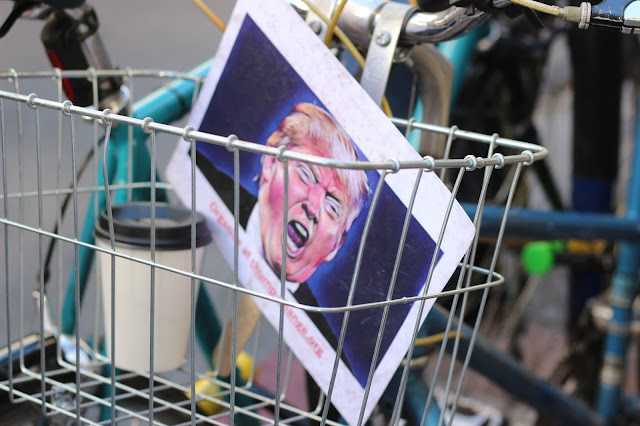Anything going on besides Trump, and does anybody care ? Well, there's always the oil price ...... ref :- "Opec approaches meeting with shrunken ambition" , The Financial Times, INSIGHT by David Sheppard, Markets and Investing
Yesterday we had a look at the effects that President Trump's
"unorthodox" methods and actions were having on the US dollar. Well,
let's face it we could write about Mr Trump every day, and often it's difficult
not to. Today would be a case in point, such are the market anxieties provoked
by the latest "revelations" of what of this particular leader of the
free world may or may not have been up to. It's not just the dollar either,
though the US unit did oblige with its biggest one day fall since July. US
stocks had their worst day since September, and all the familiar
"risk-off"safe-havens were in big demand : Jap Yen, highly-rated
Government Bonds (esp. US Treasuries), Gold.
It's no wonder Mr Trump has all the headlines, but traders have
got to cast their gaze beyond a White House under siege. For instance, this
time next week (Thurs 25th May) OPEC members will meet in Vienna, with a few
key non-OPEC producers in attendance of course. The purpose of the get-together
will be to agree on an extension to the production cuts announced last November
-- 1.3m barrels per day (bpd) within OPEC, 500,000 bpd form other
producers , mainly Russia. The news of the original six-month deal in November
prompted a rally in prices that was welcomed by producers, but by early May the
market had given back all its gains.
The problem has been that the record high level of inventories of
crude oil, the main target of the deal, has been stubbornly hard to shift. For
once, OPEC cannot be accused of non-compliance with their own quotas. All have
come at least very close to matching agreed output, and some have at times cut
by more than they were obliged to. Those looking for reasons why prices are
back where they started would point out however that although production levels
may be down , exports of oil are barely changed as exporters have made up the
difference out of their own oil reserves.
But by far the biggest reason why the oil rally went into reverse
was the resilience of U.S. shale oil producers, a factor badly underestimated
by OPEC (and others). When the original deal to cut production was struck six
months ago, OPEC was of the opinion that lower prices forcing shale rigs to
close down would see U.S. production fall by 150,000 bpd in 2017. How wrong
they were. A combination of technological advances and old-fashioned
cost-cutting means that many shale producers are happy to operate with oil at
$50 per barrel, a level not previously considered viable for most shale rigs.
Now OPEC expects U.S. production to rise by 820,000 bpd this year --
a miscalculation of nearly 1m barrels per day.
1m bpd may not be an earth-shattering number in the greater scheme
of things, but it does explain why enormously high levels of crude inventories
in the States have been so hard to shift.
The last couple of weeks have finally seen some noticeable
drawdowns in crude stocks and explains the small bounce we've seen in prices,
but for it to mean anything serious, OPEC and their confreres simply must come
up with something constructive next week. The talk for some time has been of a
six month extension to the current deal, taking it to the end of 2017. In most
people's eyes, this is an absolute minimum. Not to agree on even this would be
a disaster for prices so we'll assume for a moment (possibly very unwisely) that
it's a foregone conclusion -- most of the thirteen members have
publicly supported the idea, at any rate. The question is, will they extend the
cuts for a further nine months, until the end of March 2018 ?
That's the proposal favoured by Saudi Arabia (OPEC, and the
world's largest exporter), Russia (non-OPEC, and the world's largest producer)
and Kuwait (another OPEC heavyweight). We read somewhere this morning that the
likelihood of that happening is around 60%. Actually, we're surprised it's not
higher given how much producers have to lose if they're not judged to be making
bold moves to dramatically reduce inventories and get supply and demand back in
balance. But then again, you've got to remember that the recently harmonious
front presented by OPEC is an exception rather than the rule, and members have
differing needs and priorities.
The FT's point is that OPEC are of course aware of the need to be
seen to take constructive action, and at the same time they're realistic enough
to understand that they can only expect to achieve so much. The suggestion is
knocking around that they might not extend the deal beyond six months but
deepen the cuts instead. That probably would cause a quick drawdown in
inventories and a spike in prices, but it's one that's likely to be short-lived
and what's worse it would bring the shale players even more strongly into play.
Never say never when it comes to OPEC but it seems much more
likely that they'll take the view that a lengthy period of more modest cuts
will achieve their reduced goals. Gone are the days when OPEC could do pretty
much what it pleased, and you get the impression that they'd rather settle for
an oil price around $60 (or a fraction more) than risk the calamitous prospect
of $40 oil once again.



No comments